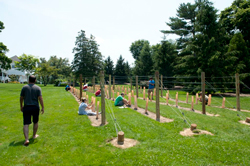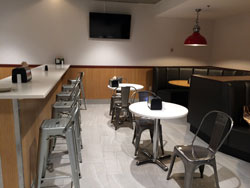In order to provide students with hands on experience in the field of biology and botany, the University has created a vineyard on campus as a part of the biology curriculum.
The idea of the vineyard originated from Dr. Pedram Daneshgar, assistant biology professor. According to Daneshgar, the purpose of the project is to fuse together the biology curriculum taught in the classroom with real life experiments that will expose students to the material they learn. “The Monmouth University campus vineyard is essentially an outdoor laboratory designed to help students learn about sustainable agricultural practices, integrated pest management practices, growth preferences of grapes, proper cultivation of grape vines and other aspects of vineyards such as wine production,” said Michael Palladino, Dean of the School of Science. “The vineyard also has the potential to help students learn about aspects of grape genetics and about the genetics of bacteria and yeast that live on grape vines and are essential for wine production.”
“The main goal of this botany project is to teach students about sustainable agriculture and what it takes to successfully grow a vineyard,” Daneshgar said.
Daneshgar, an ecologist specializing in plants who also teaches botany at the University, wanted to create a “platform to teach all biology majors.” Rather than each section of biology creating a different project, the vineyard project will serve as a tool to connect all students within the field of study.
“One aspect of Daneshgar’s vision for this project is to incorporate aspects of the vineyard as a theme connecting multiple biology courses,” Palladino said. “In introductory courses and plant science courses, students can learn about fundamental aspects of plant biology using the vineyard, and in upper level courses, students can learn about concepts in plant genetics and microbial genetics related to the vineyard.”
The project, which began in early May of 2012, involved a series of initial procedures before construction could commence. Once an appropriate location was selected, the project needed official approval and confirmation from President Paul Gaffney, who gave his permission to allow the vineyard to be constructed near the Doherty House, an ideal location for the vineyard because it is located on a slope, preventing water accumulation which is bad for the vines.
After the initial process was completed, vines from an upstate New York vineyard were ordered, and the biology students began the construction of the vineyard.
The two primary vines grown in the vineyard are Chambourcin, a red grape variety that produces a red wine with spicy undertones, and Cayuga White, a grape variety which produces a sweet and fruity white wine. Both vines were selected primarily due to their disease resistant nature and because they are both known to be successfully grown in New Jersey.
The maintenance of the vineyard is the responsibility of Daneshgar and five students who are either conducting an independent study or working as interns. Because of the currently cold weather temperatures, the group tends to the vineyard once per week. During the spring and summer months, the group will make several visits to the vineyard each week.
The group’s weekly visits consist of observing and evaluating the approximately 100 vines one by one in order to note the health of each plant. The group then collects data such as measurements of plant growth.
“The weekly visits contribute to the hands on experience and overall understanding of the factors which influence plant growth,” said Daneshgar. “When the project reaches the wine production stage, the students will learn about fermentation.”
The group’s visits have seen success up to this point with very few issues.
“The only issue we’ve really had was a deer problem, but we made some spray with mint and garlic, sprayed the plants, and the plants were fine,” Daneshgar said.
Because the Doherty House is used for many University events, it would not be possible to construct a deer fence, so the group continues to rely upon its organic repellant spray.
Another significant problem was the effect of Hurricane Sandy. During their most recent visit, the group did observe evidence of salt spray, and much of the vines had lost its leaves. However, because many vines lose their leaves during the winter, the true damage will not be recognizable until the spring and summer months. Daneshgar expects one quarter of the vines to die as a result of a combination of both Hurricane Sandy and the winter weather.
Although the project is meant to serve as a learning tool for biology students, “any student who wants to do something with the vineyard is more than welcome to get involved,” Daneshgar said.
The project also plans on getting involvement from other departments in the future as the project grows and progresses. “We would like to reach out to the art department to design wine labels, as well as the business department about marketing the wine,” Daneshgar said.
The initial startup capital required was $2,000, which covered the cost of the vines, the equipment needed to construct the trellis system which supports the vines as they grow, as well as the equipment rented to prepare the soil. The fixed cost of the project totals less than $500 per year which covers the cost of fertilizers and sprays. The overall funding comes from the biology department, but the department is hoping to gather more financial support to help pay for materials and equipment.
Long term funding will eventually become of great concern, especially when the vineyard is ready to produce wine because of the very costly wine making machinery.
The project has received ongoing support from John and Janet Giunco, owners of the award winning Four JG’s vineyard in Colts Neck, who serve as the primary advisors to Daneshgar throughout the process.
“The Giuncos have been invaluable for guiding Daneshgar on how to develop the vineyard. The Giuncos provided Daneshgar with growing tubes to support the vines, contact information for key vendors from whom to purchase vines and supplies, and they helped with a soil analysis to determine the nutrition content [in order to determine a suitable vineyard location],” Palladino said.
The vineyard is currently in its early stages, so it is not producing grapes, but Daneshgar is optimistic that grapes suitable for wine production will begin to grow within 3-4 years. Once the vineyard has reached its peak, it should be able to produce 300- 400 bottles of wine per year, according to Daneshgar.
Because much of the project is in the planning stages, it is not official what will happen to the bottled wine.
“It will either be sold, or it will be used at Monmouth’s formal events such as Alumni Day or Homecoming,” said Daneshgar.
The vineyard project is still in its premature phase, but volunteers are welcome to get involved.
“We envision the vineyard as a resource of pride for the campus,” Palladino added. “I encourage any students or faculty interested in learning more about working the vineyard to contact Daneshgar.”
PHOTO COURTESY of MU Photography




